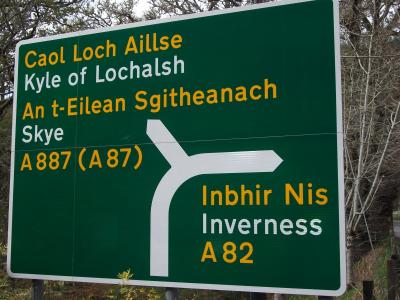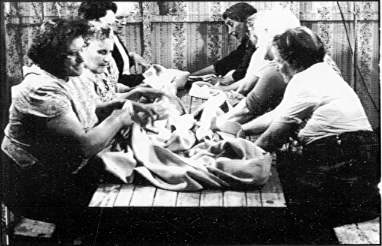Categories
Òrain Gàidhlig – Scottish Gaelic Song
by Nadine Lee

One of the experiences that stood out the most on my Highland adventure a few months back was the amount of Scottish Gaelic I encountered. From road and railway station signs, to the greeting displayed on the entrance to McDonalds in Inverness, this was my first encounter with Scotland’s oldest surviving spoken language. It’s something you don’t really come across in Edinburgh, either because the language is spoken by less than 2% of the Scottish population, or because Lowland Scots has been the traditional form of speech in the south.
Sadly Scottish Gaelic has been in steady decline for quite some time. 100 years ago the amount of bilingual Scots numbered 183,998. At the time of the last census in 2001, only 58,652 people were registered as bilingual in Gaelic. Nevertheless, the language is in the midst of a government supported revival. BBC’s Gaelic television station Alba reportedly gets on average 530,000 viewers per week, and Edinburgh’s Gaelic primary school is currently at full capacity, prompting a relocation to a larger campus later in the year.
Apart from place names, I had never spoken a word of Gaelic in my life until last Friday when I attended a Gaelic harmony singing workshop. Held at the Scottish Storytelling Centre on Edinburgh’s Royal Mile, I arrived a little early and sat trying to figure out how to pronounce the lyrics on the handout I’d received. I have never encountered a language quite like it before – the words are pronounced entirely differently to how you would expect them to sound. This makes reading Gaelic when beginning to learn a little bit perplexing. I found it much easier to watch and listen to how it looks and sounds, mimicking rather than trying to read.
The workshop was lead by well-known Gaelic singer Gillie Mackenzie. Gillie grew up in Lewis but now lives in the Lothians, and has been singing ever since she can remember. Family ceilidhs instilled an early understanding of vocal harmony and she fondly told us how her and her sisters would sing and harmonise together in Gaelic while doing the dishes at home. Gillie currently teaches Gaelic song and conducts the Gaelic choir at Bunsgoil Crois na Cìse (the Gaelic medium unit at Edinburgh’s Tollcross Primary School), and recently began a Gaelic choir at James Gillespie’s High School. She released her first solo album entitled Griais in 2012 and is currently touring with her band.
We began by singing two traditional songs (Tobair Tobair Siolaidh and ‘S Toigh Leam Fhin Buntat ‘s ìm); first as a group, then combined with different vocal harmonies, and finally in round. It sounded absolutely glorious and I wondered if the tourists just outside the window walking up and down the high street could hear us singing in ancient Scottish tongue. The first few times we went through the song I felt completely lost with the language, but as we repeated the song my mouth was slowly becoming accustomed to this new way of speaking. We then learnt a beautiful song called Gleanna Gollaidh by Robert Donn (1714-78). Donn was a well-known bard hailing from Sutherland (Mackay country), with this particular song praising a glen in his district:
Gleann-a-Gallaidh, Gleann-a-Gallaidh, (Glen Gollaidh, Glen Gollaidh)
Gleann-a-Gallaidh nan craobh, (Glen Gollaidh of our trees)
Cò a chì e nach mol e, (Who can see it without praising it?)
Gleann-a-Gallaidh nan craobh. (Glen Gollaidh of our trees)
Ri faicinn crìoch àrdain (Seeing the abutment of its elevation)
Ga mo bhreugadh gu taobh, (Drew me aside)
‘S ann a smuainich mi fanadh (Indeed I thought of staying in)
An Gleann-a-Gallaidh nan craobh. (Glen Gollaidh of the trees)
Chan àill leam bhur n-airgead (I don’t desire your money)
‘S ri bhur n-arm cha bhi mi, (And I’ll never join your army)
Cha diùlt mi bhur drama (I won’t refuse your dram)
Ach ri tuilleadh cha bhì. (But I’ll do no more than that)
Ged a gheibhinn gu m’ àilgheas (Though I might get to my desire)
Ceann-t-sàile MhicAoidh, (Mackay’s Kintail)
‘S mòr a b’ annsa leam fanadh (More I fancy staying)
An Gleann-a-Gallaidh nan craobh. (In Glen Gollaidh of the trees)
Fonn diasach, ‘s mòr a b’ fhiach e (Bountiful land, much of its value)
Gu fiadhach ‘s gu nì, (For stalking and cattle)
Aite sìobhalt ri doineann (An agreeable place in time of storm)
Is nach criothnaich a’ ghaoth. (In which the wind will not shudder).
Coincidentally, Donn was writing poetry around the same time as the 1745 Jacobite Rising. An ardent Jacobite supporter, Dunn upset the Hanoverian chief of Clan Mackay by writing this poem about the rising:
Now, young Charles Stewart
Every clan places its hope in you
That sought to crown you
And set the country alight;
They’re like hidden snakes
Which cast their skins last year
But are making ready their fangs
To arise on the day of your coming

Waulking in Iochdar, South Uist, June 1970
We finished the workshop with an Isle of Lewis waulking song called Bodachan Cha Phòs mi. These songs were traditionally sung by women waulking cloth and were an institution in female Gaelic society. This practice involved a group of women beating newly woven tweed rhythmically against a table or similar surface to soften it. As the singers worked the cloth, they gradually shifted it to the left so as to work it thoroughly. Typically one person would sing the verse, while the others joined in the chorus. A night at a waulking was a tremendous social outlet for women. The songs have a strong element of gossip in them, of exchanging secrets, of comments on men, good and bad. Although some songs were light-hearted and trivial, many were intimate, frank, intensely vivid, and expressive statements of women’s experiences.
A week since the workshop, I’m suprised at how well I have remembered the melody and the language I learnt. I have quite often found myself humming the songs, especially the beautiful Gleanna Gollaidh. Sadly the only statistics I can find online regarding Scotland’s Gaelic speakers date from 2001, but I would love to know if efforts since have increased the number of speakers of this fascinating language.
——-
You can listen to Gleanna Golaidh by visiting the BBC’s Year of Song website below, and they also have a great ‘teach yourself Gaelic’ website for absolute beginners called Beag air Bheag.
Another great resource for Scottish oral recordings is Tobar an Dualchais where you can hear many Gaelic recordings.
Tweet
- June 20, 2013 5:00 pm
- ·
 Margaret Moffet, Donald, Bette Ellis and 1 other person likes this.
Margaret Moffet, Donald, Bette Ellis and 1 other person likes this.
Margaret Moffet
Well done Nadine, you will be a native in no time.
- June 21, 2013
- ·
- Like
- ·
- 1 person
Chas Mac Donald
Ooooft Nadine. You should try learning it, then you'll know how weird the spelling is! But well done you for getting into that! The more the better. 'S math a rinn thu!
- June 23, 2013
- ·
- Like
- ·
- 2 people
Pauline Campbell
Gosh...I have enough trouble understanding a broad Scottish accent let alone Gaelic!!
- June 23, 2013
- ·
- Like
- ·
- 1 person
Nadine Lee
I would really love to learn more! I've found a Gaelic choir in Edinburgh that I want to join but sadly they're on hiatus over the summer! Thanks for commenting 
- June 23, 2013
- ·
- Like



